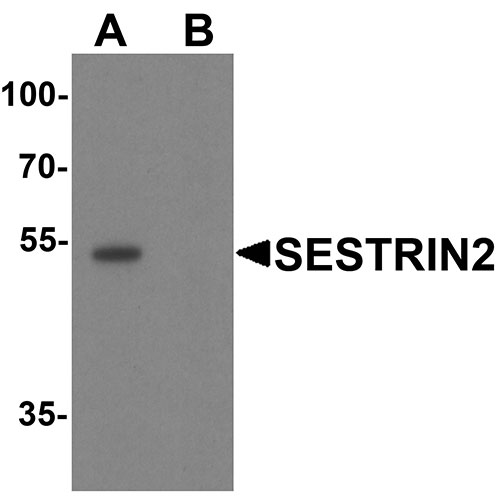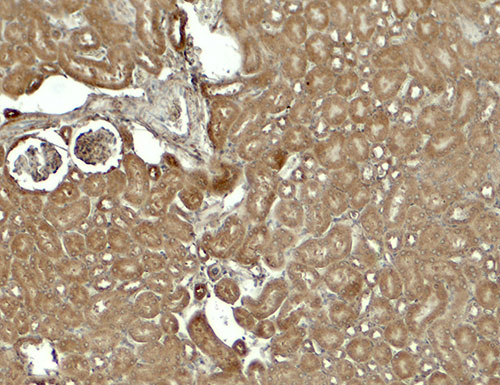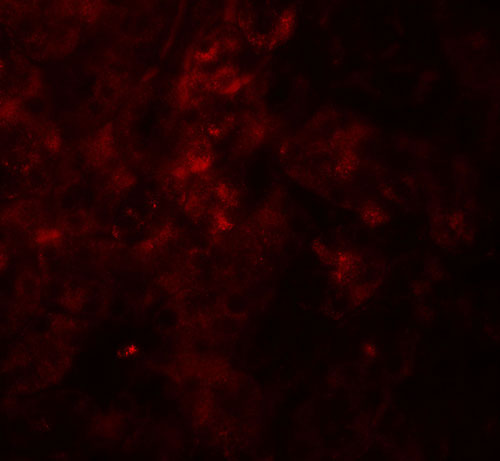SESTRIN2 Antibody
- 产品详情
- 实验流程
- 背景知识
Application
| WB, IF, E, IHC-P |
|---|---|
| Primary Accession | P58004 |
| Other Accession | NP_113647, 13899299 |
| Reactivity | Human, Mouse, Rat |
| Host | Rabbit |
| Clonality | Polyclonal |
| Isotype | IgG |
| Calculated MW | 54494 Da |
| Concentration (mg/ml) | 1 mg/mL |
| Conjugate | Unconjugated |
| Application Notes | SESTRIN2 antibody can be used for detection of SESTRIN2 by Western blot at 1 - 2 µg/ml. Antibody can also be used for immunohistochemistry starting at 5 µg/mL. For immunofluorescence start at 20 µg/mL. |
| Gene ID | 83667 |
|---|---|
| Other Names | Sestrin-2, Hi95, SESN2, SEST2 |
| Target/Specificity | SESN2; SESTRIN2 antibody is human, mouse and rat reactive. At least two isoforms of SESTRIN2 are known to exist; this antibody will detect both isoforms. SESTRIN2 antibody is predicted to not cross-react with SESTRIN1. |
| Reconstitution & Storage | SESTRIN2 antibody can be stored at 4℃ for three months and -20℃, stable for up to one year. |
| Precautions | SESTRIN2 Antibody is for research use only and not for use in diagnostic or therapeutic procedures. |
| Name | SESN2 (HGNC:20746) |
|---|---|
| Function | Functions as an intracellular leucine sensor that negatively regulates the mTORC1 signaling pathway through the GATOR complex (PubMed:18692468, PubMed:25263562, PubMed:25457612, PubMed:26449471, PubMed:26586190, PubMed:26612684, PubMed:31586034, PubMed:35114100, PubMed:35831510, PubMed:36528027). In absence of leucine, binds the GATOR subcomplex GATOR2 and prevents mTORC1 signaling (PubMed:18692468, PubMed:25263562, PubMed:25457612, PubMed:26449471, PubMed:26586190, PubMed:26612684, PubMed:31586034, PubMed:35114100, PubMed:35831510, PubMed:36528027). Binding of leucine to SESN2 disrupts its interaction with GATOR2 thereby activating the TORC1 signaling pathway (PubMed:26449471, PubMed:26586190, PubMed:35114100, PubMed:35831510, PubMed:36528027). This stress-inducible metabolic regulator also plays a role in protection against oxidative and genotoxic stresses. May negatively regulate protein translation in response to endoplasmic reticulum stress, via mTORC1 (PubMed:24947615). May positively regulate the transcription by NFE2L2 of genes involved in the response to oxidative stress by facilitating the SQSTM1-mediated autophagic degradation of KEAP1 (PubMed:23274085). May also mediate TP53 inhibition of TORC1 signaling upon genotoxic stress (PubMed:18692468). Moreover, may prevent the accumulation of reactive oxygen species (ROS) through the alkylhydroperoxide reductase activity born by the N- terminal domain of the protein (PubMed:26612684). Was originally reported to contribute to oxidative stress resistance by reducing PRDX1 (PubMed:15105503). However, this could not be confirmed (PubMed:19113821). |
| Cellular Location | Cytoplasm. |
| Tissue Location | Widely expressed.. |
For Research Use Only. Not For Use In Diagnostic Procedures.
Provided below are standard protocols that you may find useful for product applications.
BACKGROUND
SESTRIN2, also known as Hi95, is a member of the sestrin family of PA26-related proteins and is induced following DNA damage or oxidative stress (1). SESTRIN2 and the related protein SESTRIN1 interact with the NRF2 suppressor KEAP1, the autophagy substrate p62 and the ubiquitin ligase RBX1 to protect cells against oxidative stress by activating NRF2 and promoting the p62-dependent autophagic degradation of KEAP1 (2). SESTRIN2 also negatively regulates TOR signaling by activating AMP-activated protein kinase (AMPK) and TSC2 phosphorylation (3), thereby protecting cells against energetic stress-induced death (4).
REFERENCES
Budanov AV, Shoshani T, Faerman A, et al. Identification of a novel stress-responsive gene Hi95 involved in regulation of cell viability. Oncogene 2002; 21:6017-31.
Bae SH, Sung SH, Oh SY, et al. Sestrins activate Nrf2 by promoting p62-dependent autophagic degradation of Keap1 and prevent oxidative liver damage. Cell Metab. 2013; 17:73-84.
Budanov AV and Karin M. p53 target genes sestrin1 and sestrin2 connect genotoxic stress and mTOR signaling. Mol. Cell 2008; 134:451-60.
Ben-Sahra I, Dirat B, Laurent K, et al. Sestrin2 integrates Akt and mTOR signaling to protect cells against energetic stress-induced death. Cell Death and Diff. 2013; 20:611-9.
终于等到您。ABCEPTA(百远生物)抗体产品。
点击下方“我要评价 ”按钮提交您的反馈信息,您的反馈和评价是我们最宝贵的财富之一,
我们将在1-3个工作日内处理您的反馈信息。
如有疑问,联系:0512-88856768 tech-china@abcepta.com.























 癌症的基本特征包括细胞增殖、血管生成、迁移、凋亡逃避机制和细胞永生等。找到癌症发生过程中这些通路的关键标记物和对应的抗体用于检测至关重要。
癌症的基本特征包括细胞增殖、血管生成、迁移、凋亡逃避机制和细胞永生等。找到癌症发生过程中这些通路的关键标记物和对应的抗体用于检测至关重要。 为您推荐一个泛素化位点预测神器——泛素化分析工具,可以为您的蛋白的泛素化位点作出预测和评分。
为您推荐一个泛素化位点预测神器——泛素化分析工具,可以为您的蛋白的泛素化位点作出预测和评分。 细胞自噬受体图形绘图工具为你的蛋白的细胞受体结合位点作出预测和评分,识别结合到自噬通路中的蛋白是非常重要的,便于让我们理解自噬在正常生理、病理过程中的作用,如发育、细胞分化、神经退化性疾病、压力条件下、感染和癌症。
细胞自噬受体图形绘图工具为你的蛋白的细胞受体结合位点作出预测和评分,识别结合到自噬通路中的蛋白是非常重要的,便于让我们理解自噬在正常生理、病理过程中的作用,如发育、细胞分化、神经退化性疾病、压力条件下、感染和癌症。








